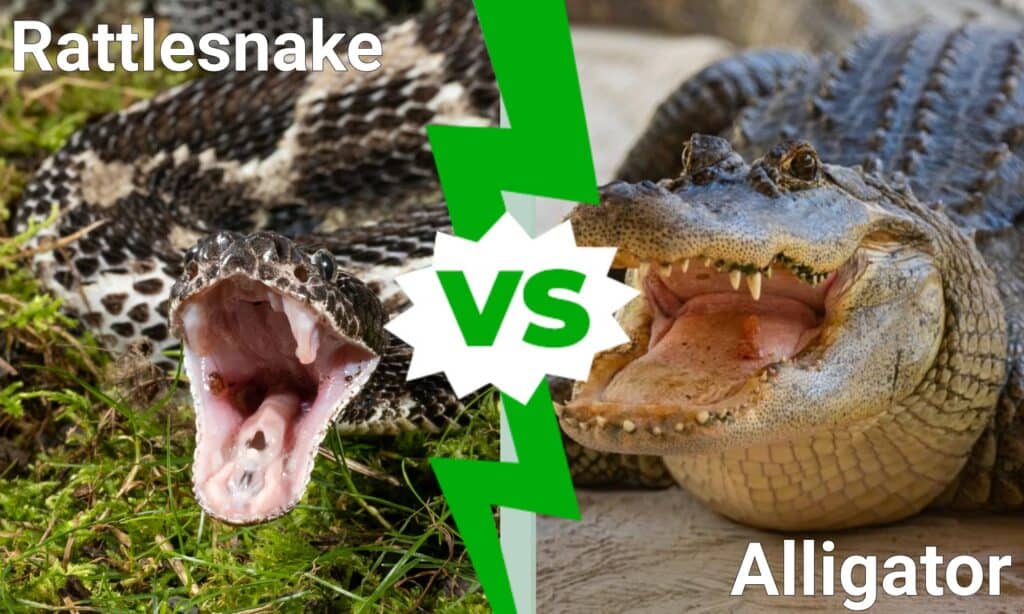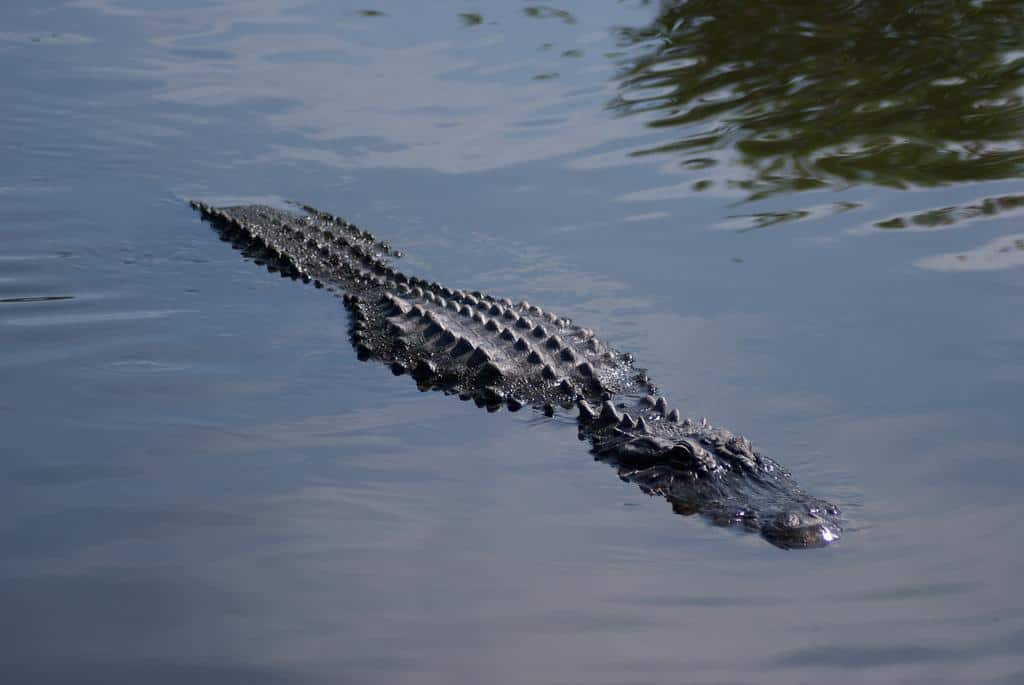Rattlesnakes and alligators are both notorious predators. Rattlesnakes fight with formidable fangs and incredible striking power. Alligators battle with their impressively strong jaws and sharp teeth. Both catch their victim by total surprise, often hidden out of sight just before an attack. Who has the strength, agility, and strategy to be victorious? Let’s break down the details of a rattlesnake vs alligator match and determine who will win the fight.
Comparing a Rattlesnake and an Alligator

| Rattlesnake | Alligator | |
|---|---|---|
| Size | 2.5-5 ft, up to 8 ft, up to 10 lbs | 9-13+ feet, Over 600 lbs |
| Movement & Speed | 2-3 mph, can accurately strike from a distance of 1/2 body length | 20 mph in water, 30 mph on land |
| Attack Method | Strike with venomous fangs | Lunge and bite with strong jaws |
| Defenses | Defensive open-mouthed display & hissing, Rattling tail | Protective armor-like body coating, tail as a defense |
| Predatory Behavior | Ambush predator | Ambush predator |
| Unique Sensory Adaptation | Pit organs | Integumentary sense organs |
Key Differences Between a Rattlesnake and an Alligator

Rattlesnakes and alligators differ in size, morphology, defensive and attack methods.
©Audrey Snider-Bell/Shutterstock.com
The main differences between a rattlesnake and an alligator are their size, speed, morphology, as well as defensive and attack methods. Rattlesnakes are scale-covered, venomous pit vipers. They have a distinctive rattle at the end of their tails. Alligators are very large crocodilian reptiles with bodies plated in armor-like scales. In terms of size, male alligators can grow to be more than 13 feet long and weigh over 600 pounds. Females tend to be smaller, reaching up to 9 feet in length from head to tail and weighing more than 200 pounds. The largest species of rattlesnake, the eastern diamondback, can grow to be up to 8 feet long and weigh 10 pounds.
The size difference between these reptiles alone would make the battle of alligator vs rattlesnake interesting. However, we also need to look at other factors that will be specific to the outcome of a fight between these powerful predators.
What are the Key Factors in a Rattlesnake vs Alligator Fight?

Alligators can grow to weigh over 600 pounds.
©iStock.com/tobiasfrei
Some key factors in a rattlesnake vs alligator fight would be their size, speed, and attacking methods. Additionally, we need to consider their physical defenses and predatory behavior to determine who would be victorious in this match.
Rattlesnake vs Alligator: Size
Rattlesnakes grow to a range of sizes, depending on the species. The timber rattlesnake is generally 2.5 to 5 feet long, but some can reach 7 feet. As we already mentioned, the eastern diamondback is the largest rattlesnake species, growing up to 8 feet in length and weighing up to 10 pounds. The largest of alligators would be in excess of 13 feet long and 600 pounds. Overall, the alligator is a much larger animal than the rattlesnake.
Alligators have the size advantage over rattlesnakes.
Rattlesnake vs Alligator: Speed & Movement

Rattlesnakes can strike in the blink of an eye.
©Tim Malek/Shutterstock.com
Rattlesnakes are primarily terrestrial, spending most of their time on land. However, they actually are quite capable swimmers. Rattlesnakes may be able to keep up with alligators, skilled swimmers that do much of their hunting in water. Rattlesnakes are only adept at striking from a coiled position, so they would be at a disadvantage if they needed to defend themselves in water. On land, they’re capable of an accurate and well-placed strike of about half their body length. So, if we consider an 8-foot rattlesnake, it can strike from 4 feet away.
Rattlesnakes tend to move relatively slowly when not striking, with an average speed of 2 to 3 miles per hour. You might think that alligators are slow-moving, but they can reach impressive speeds. They can reach 30 miles per hour on land and 20 miles per hour in water. Alligators can push themselves up with their strong, muscular tails and jump up to five feet out of the water to snag a meal.
Alligators have the speed advantage over rattlesnakes.
Rattlesnake vs Alligator: Attack Method
Alligators lunge toward their catch and use their strong, broad jaws to capture prey and often drag it underwater to drown before devouring. American alligators hold the record of having the strongest measured bite of any living animal, up to 13,172 newtons. Rattlesnakes attack by striking their prey and sinking their powerful fangs into their victim. Their fangs deliver venom immediately; it takes half a second for them to strike and paralyze prey. Their hemotoxic venom works by destroying red blood cells, leading to organ degeneration and tissue damage. Some species, like the mojave, speckled, and tiger rattlesnakes have neurotoxic venom, which acts faster than hemotoxins and attacks the nervous system. Rattlesnakes’ bite force of around 600 newtons pales compared to the alligators. However, their bite doesn’t need to be equally matched if they can make a strike to deliver their powerful venom.
In terms of attack method, rattlesnakes and alligators are well-matched.
Rattlesnake vs Alligator: Physical Defenses

Alligators and rattlesnakes are both skilled ambush predators.
©Peter & Michelle S / CC BY 2.0, Flickr – License
As apex predators, alligators don’t generally have to worry about predation. If necessary, they can use their powerful tails as a weapon of defense. Alligators are adept at surprising their victims. Their eyes, ears, and nostrils are located on top of their heads and project slightly above the water as they float on water. They use calls and deep bellowing to declare their territory and threaten competitors. These tough reptiles are coated with the protective shell of an armor-like, scaly body. This makes it extremely difficult for other creatures to inflict serious harm. New research shows that alligators might actually have physiological resistance to snake venom. They can consume pit vipers with no ill effects, and this resistance likely protects them if they were to be bitten.
Rattlesnakes are adept at camouflage, keeping still and relying on their ability to blend in with their environment to avoid alerting menacing predators and promote the capture of passing prey. In addition to shaking the rattles at the ends of their tails to warn of a strike, rattlesnakes will often hiss like a cat. Their body will swell and deflate as they take air in and out to produce the sound. If they feel threatened, they move to coil in a tight circle and raise their heads in preparation for the strike.
Alligators have the defensive advantage.
Rattlesnake vs Alligator: Predatory Behavior
Both ambush predators, rattlesnakes, and alligators, have evolved unique features suited to taking down prey. Each uses the method of sitting still and idly waiting for unsuspecting prey to pass by. As pit vipers, rattlesnakes have heat-sensing pit organs located near their eyes. These allow them to sense the heat signatures of animals around them. So even in the dark, they’d be able to strike accurately. They have a highly-developed organ or chemoreception called Jacobson’s organ that allows them to detect and hunt their prey.
Alligators are nocturnal hunters with sharp vision and unique sensory organs in their scales called integumentary organs. These are small, dome-shaped spots that cover their face. Under each dome is a network of touch-sensitive receptor cells and nerves. These are extremely sensitive and react to touch, even moving water. They likely help alligators locate and capture prey even when sight and sound cues are limited. Alligators and rattlesnakes are both ambush predators with unique adaptations to predatory success.
In terms of predatory behavior, rattlesnakes and alligators are well-matched.
Who Would Win in a Fight Between a Rattlesnake and an Alligator?
Although these reptiles are well-matched regarding predatory behavior and method of attack, alligators have the upper hand in this battle. Alligators have the advantages over rattlesnakes in size, speed, and defense. Their protective body coating would make it exceptionally difficult for a rattlesnake to deliver the venom it would need to inject to win the fight. Alligators’ oversized form and capacity for speed would be strong factors in defeating these venomous serpents. They’ve been known to consume venomous pit vipers like rattlesnakes, apparently resistant to any ill effects of their venom. A baby alligator might be in danger if it encounters a hungry rattlesnake. However, if we consider adults in the battle of rattlesnake vs alligator, the alligator is the clear winner.
The photo featured at the top of this post is © iStock.com/Bradley Proxmire
Thank you for reading! Have some feedback for us? Contact the AZ Animals editorial team.






